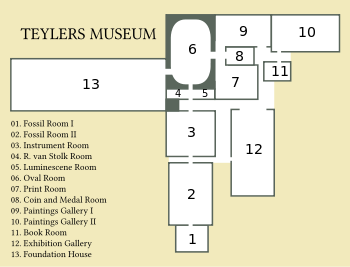Teylers Oval Room
The Oval Room in the Teylers Museum was the first part of the museum (though it was not called a museum yet) that was opened in 1784. It could be entered through the garden of the fundatiehuis, the former home of Pieter Teyler van der Hulst. The building has an oval shape built around its centerpiece, a mineralogical cabinet. The Oval Room consists of two floors; the ground floor with its display cabinets and a gallery of books that connects to the Teylers Library. On top of the room, on the roof, the astronomical observatory used to be a landmark that could be seen for miles along the river Spaarne. The gallery and observatory are longer accessible to the public, though the gallery can be seen from the ground floor.
In 1779 the board of the Teylers Foundation (Teylers Stichting) commissioned Leendert Viervant, the Amsterdam-based architect of amongst others the church of Ouderkerk aan den Amstel and the town hall of Weesp to build a "book and hobby room" or "book and art room" (boek- en liefhebberyzaal or Boek en Konstzael) in the garden of the former house of Pieter Teyler. After his death, Teyler bequeathed a fortune for the pursuit of science, religion, and the arts. His house had been renamed the fundatiehuis to house this fundatie or foundation. The collections of Pieter Teyler himself, but also of the foundation, was growing and space was needed to show the collections in an appropriate way, while also affording space to hold lectures for teaching and to conduct lab experiments with the expensive instruments that had been purchased. Viervant designed both the mineralogical cabinet and the room around it in the neoclassicist style that was popular in the Netherlands at that time. For example, the Ionic order was chosen by Viervant for the columns in the room because it was regarded as the "ideal order for the dignified control and moderation associated with the arts and sciences".
...
Wikipedia


